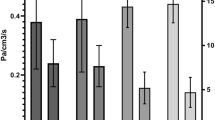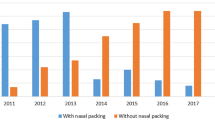Abstract
Evaluation of endoscopic ethmoidectomy performed as a day-case in terms of security, quality, and satisfaction of the patient. This prospective observatory bi-centric study over 1 year included 74 patients undergoing an ethmoidectomy respecting the eligibility criteria of ambulatory care. We recorded patients’ demographic data, operative details, satisfaction, postoperative course, and follow-up results. Nasal symptoms were evaluated by SNOT-22 on preoperative appointment and postoperatively at D30. No non-absorbable nasal packing was used, eventually in the case of preoperative-bleeding absorbable gelatine packing. The postoperative follow-up took place at D1 by phone call and at D10 and D30 to assess complications, Visual Analogue Scale, and state of ethmoidal corridors by endoscopic exam. Patients benefited of bilateral ethmoidectomy in 82.4 % cases associated with septoplasty in 42 %. The majority (95 %) was discharged on the same day. Only one patient had bleeding at D0 and was kept in standard hospitalization, such as three other patients for medical or organizational reasons not related to surgery. At D1, 23 % described postoperative light bleeding but needed no revisit and pain was estimated at 1.3 (VAS). No readmission was observed, and no major complication was noted. SNOT-22 decreased successfully by 56 %, statistically related to postoperative treatment of corticosteroids and in the case of Samter triad. 97 % of patients were satisfied of the ambulatory care. These results suggest that within an experienced and dedicated day-case medical and paramedical team, ethmoidectomy can be safely performed on a day-case basis with high quality of taking care and satisfaction of patients.



Similar content being viewed by others
References
Haute Autorité de Santé. Ensemble pour le développement de la chirurgie ambulatoire. Socle de connaissances. Saint-Denis La Plaine, Paris: HAS, ANAP; 2012. http://www.has-sante.fr/portail/upload/docs/application/pdf/2012-04/rapport-socledeconnaissances.pdf. Accessed 2 Apr 2016
Haute Autorité de Santé. Ensemble pour le développement de la chirurgie ambulatoire. Tarification de la chirurgie ambulatoire en France et à l’étranger. Etat des lieux et perspectives. HAS, ANAP; 2013. http://www.has-sante.fr/portail/upload/docs/application/pdf/2013-09/rapport_dorientation_-_tarification_de_la_chirurgie_ambulatoire_en_france_et_a_letranger.pdf. Accessed 2 Apr 2016
Association of Anaesthetists of Great Britain and Ireland, British Association of Day Surgery (2011) Day case and short stay surgery: 2. Anaesthesia 66(5):417–434
Guidelines for Ambulatory Anesthesia and Surgery, Committee of Origin: Ambulatory Surgical Care—approved by the ASA House of Delegates on October 15, 2003, and last amended on October 22, and reaffirmed on October 16, 2013. http://www.asahq.org. Accessed 2 Apr 2016
de Gabory L et al (2015) French Otorhinolaryngology Society guidelines for day-case nasal surgery. Eur Ann Otorhinolaryngol Head Neck Dis 132(1):35–40
Hopkins C et al (2007) Variation in day-case nasal surgery—why cannot we improve our day-case rates? Clin Otolaryngol 32(1):12–18
Al-Hussaini A et al (2015) Day-case septoplasty: a default pathway or is case selection the key? Eur Arch Otorhinolaryngol 272(1):91–95
Bhattacharyya N (2010) Ambulatory sinus and nasal surgery in the United States: demographics and perioperative outcomes. Laryngoscope 120(3):635–638
Suzuki S et al (2015) Complication rates after functional endoscopic sinus surgery: analysis of 50,734 Japanese patients. Laryngoscope 125(8):1785–1791
Rudmik L et al (2015) Using preoperative SNOT-22 score to inform patient decision for Endoscopic sinus surgery. Laryngoscope 125(7):1517–1522
de Dorlodot C et al (2014) French adaptation and validation of the sino-nasal outcome test-22: a prospective cohort study on quality of life among 422 subjects. Clin Otolaryngol 40(1):29–35
Hildenbrand T (2013) A new gelatine-based hemostat for sinonasal surgery: a clinical survey. Vivo 27(4):523–526
Georgalas C et al (2006) Day-case septoplasty and unexpected re-admissions at a dedicated day-case unit: a 4-year audit. Ann R Coll Surg Engl 88(2):202–206
Re M et al (2012) Traditional endonasal and microscopic sinus surgery complications versus endoscopic sinus surgery complications: a meta-analysis. Eur Arch Otorhinolaryngol 269(3):721–729
Bajaj Y et al (2009) Endoscopic sinus surgery as day-case procedure. J Laryngol Otol 123(6):619–622
Hogg RP, Prior MJ, Johnson AP (1999) Admission rates, early readmission rates and patient acceptability of 142 cases of day case septoplasty. Clin Otolaryngol Allied Sci 24(3):213–215
Bhattacharyya N (2014) Unplanned revisits and readmissions after ambulatory sinonasal surgery. Laryngoscope 124(9):1983–1987
Wong A, Kacker A (2014) Incidence of unplanned admissions after sinonasal surgery: a 6-year review. Int Forum Allergy Rhinol 4(2):143–146
Poetker DM et al (2013) Oral corticosteroids in the management of adult chronic rhinosinusitis with and without nasal polyps: an evidence-based review with recommendations. Int Forum Allergy Rhinol 3(2):104–120
Eisenberg G et al (2008) Nasosinusal endoscopic surgery as major out-patient surgery. Acta Otorrinolaringol Esp 59(2):57–61
Abdalla S, Alreefy H, Hopkins C (2012) Prevalence of sinonasal outcome test (SNOT-22) symptoms in patients undergoing surgery for chronic rhinosinusitis in the England and Wales National prospective audit. Clin Otolaryngol 37(4):276–282
Wright ED, Agrawal S (2007) Impact of perioperative systemic steroids on surgical outcomes in patients with chronic rhinosinusitis with polyposis: evaluation with the novel Perioperative Sinus Endoscopy (POSE) scoring system. Laryngoscope 117(11 Pt 2 Suppl 115):1–28
Ye J et al (2009) Technique and results of the anterior-to-posterior-to-anterior approach in revision endoscopic sinus surgery. ORL J Otorhinolaryngol Relat Spec 71(5):257–262
Lemos P et al (2009) Patient satisfaction following day surgery. J Clin Anesth 21(3):200–205
Garcia Duran A et al (2003) Levels of satisfaction and perceived quality in a day surgery unit of a tertiary referral hospital. Rev Esp Enferm Dig 95(12):851–862
Author information
Authors and Affiliations
Corresponding author
Ethics declarations
Conflict of interest
No conflict of interest.
Ethical approval
This study is in accordance with the 1964 Helsinki declaration and its later amendments and with the ethical standards of the institutional and national research committee: a declaration was submitted to the CNIL (Commission Nationale de l’Informatique et des Libertés, France) for each center and accepted the 7th of February 2015 under the numbers 1836375 and 1834502, respectively. The protocol was validated by the Ethic Committee with the number 2015/CE19.
Additional information
N. Oker and V. Dupuch are first co-authors.
Rights and permissions
About this article
Cite this article
Oker, N., Dupuch, V., Herman, P. et al. Outcomes of endoscopic ethmoidectomy performed on a day-case basis: a prospective bi-centric study. Eur Arch Otorhinolaryngol 274, 305–310 (2017). https://doi.org/10.1007/s00405-016-4263-3
Received:
Accepted:
Published:
Issue Date:
DOI: https://doi.org/10.1007/s00405-016-4263-3




